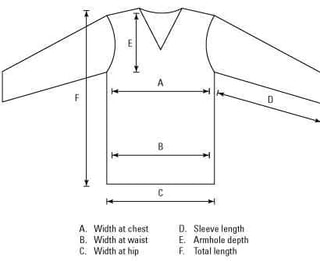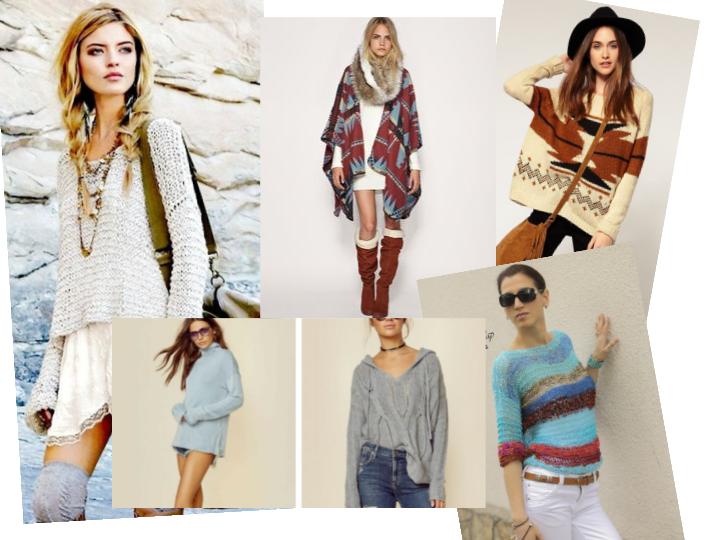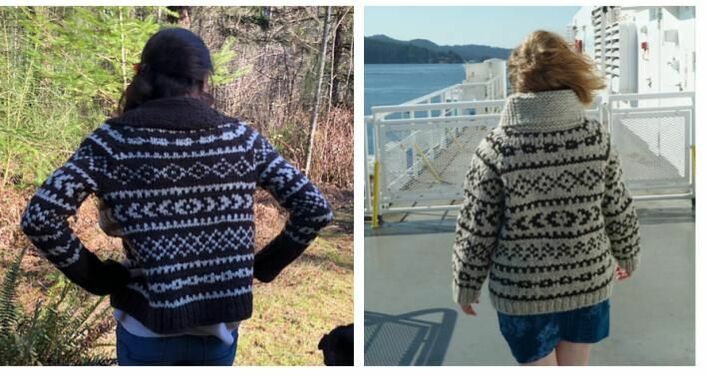Size matters. It does! The size of your stitches matter because they are what make up the fabric of the sweater you’ve chosen to knit. How many of that particular size of stitch are the reason your sweater will fit. But before we get into how they make up fabric, let’s look at sweaters themselves and how they’re suited to different body types.
There are many books and resources to help knitters wade their way through sweater styles and designs that suit different silhouettes. I recommend utilizing your public library for pattern and sweater fit books to research your body shape and sweaters styles that suit it and you. Creating a style vision board from magazines clippings or on online organizers are helpful in identifying personal style. Also, browsing finished object photos in Ravelry for people with similar body types to yours also helps with imagining how the finished sweater will fit you and what modifications, if any, you can make.
There are many books and resources to help knitters wade their way through sweater styles and designs that suit different silhouettes. I recommend utilizing your public library for pattern and sweater fit books to research your body shape and sweaters styles that suit it and you. Creating a style vision board from magazines clippings or on online organizers are helpful in identifying personal style. Also, browsing finished object photos in Ravelry for people with similar body types to yours also helps with imagining how the finished sweater will fit you and what modifications, if any, you can make.
Once you’ve decided on a sweater style and fit, it’s now time to insure it fits just the way you like. “Ease” is the word used to describe the “looseness” or “tightness” of the sweater. Sweaters with negative to zero ease are tight to your body and hug your curves. Sweaters with positive ease are looser or baggier on your body but not necessarily shapeless. Your own personal style will determine the ease you’re comfortable with. If you’re unsure of where to start I recommend checking your closet. Pick out a few sweaters or shirts you love wearing and measure them. Measure across the bust and compare that measurement to your actual bust measurement.
Another point to consider when thinking about ease is the weight of yarn you intend to use in your sweater. The fabric produced in knitting differs depending on the yarn and gauge. A bulky yarn creates a thicker fabric and thereby consumes some of the ease measurement, a thinner yarn will consume less. This means a bulky weight sweater with 1” positive ease may fit more like a sweater with zero ease because of the thickness of fabric.
Another point to consider when thinking about ease is the weight of yarn you intend to use in your sweater. The fabric produced in knitting differs depending on the yarn and gauge. A bulky yarn creates a thicker fabric and thereby consumes some of the ease measurement, a thinner yarn will consume less. This means a bulky weight sweater with 1” positive ease may fit more like a sweater with zero ease because of the thickness of fabric.
Finally, we all knit differently, there’s no right or wrong way to do it, the fabric you create is a personally expression of who you are and what is currently happening in your life. Gauge reported on a pattern is a mathematical representation of that designer’s time and space. Yours will be different, therefor, we need to test and collect data by knitting a gauge swatch. There’s really no way around it and, really, it’s just more time spent knitting so enjoy!
 Bluprint
Bluprint Knit a swatch starting with a needle size two sizes smaller than the one recommended in the pattern. Cast on about 50% to 70% more stitches then the gauge measurement tells you in the pattern. For example, the gauge measurement reported in the pattern is 22 sts in 4 inches, cast on between 11 to 15 extra stitches. Knit in pattern that the pattern reports, in general this is stockinette stitch, but can sometimes be different. If your sweater is knit in the round then knit the swatch in the round. If your sweater involves colorwork, knit a colorwork swatch. Every 3 to 4 inches of fabric (or more if the row gauge matters to sweater size), increase your needle size until you’ve increased through a total of 5 needle sizes.
Wash and block your swatch as if you were washing the sweater. I recommend for 100% animal fibres, hand wash and lay flat to dry. For linen, cotton and hemp, machine wash and dry. The fibres soften with machine washing. When working with superwash you may want to experiment further with your swatch. Superwash means that the scales on the wool have either been shaved off or glued down. This affects the wool’s elasticity and superwash wools can be more prone to stretching. After drying flat, take an initial gauge measurement. Then hang your swatch on a coat hanger, attaching it with clothes pins. Attach extra clothes pins at the bottom and leave it for 24 hours. Remeasure the gauge. If you love the pattern photos and are substituting yarn it is recommended to use a similar yarn to the pattern to have a better chance of getting the desired sweater.
When your swatch is dry choose the fabric you like best of the differing needle sizes. Measure gauge by placing a locking stitch marker in between to visible knit stitches at the furthest left hand point possible. Using a measuring tape, measure 4 inches across the fabric and place another stitch marker at exactly the 4 inch mark. Count the stitches between the markers and compare the amount to the gauge stated in the pattern. If there are not enough stitches your sweater will be too big, if there are too many stitches your sweater will be too small.
When your swatch is dry choose the fabric you like best of the differing needle sizes. Measure gauge by placing a locking stitch marker in between to visible knit stitches at the furthest left hand point possible. Using a measuring tape, measure 4 inches across the fabric and place another stitch marker at exactly the 4 inch mark. Count the stitches between the markers and compare the amount to the gauge stated in the pattern. If there are not enough stitches your sweater will be too big, if there are too many stitches your sweater will be too small.
 @what-when-how In Depth Tutorials and Information
@what-when-how In Depth Tutorials and Information In order to ensure a desired fit, and taking into account ease, the key is to find the chest circumference stitch count in the pattern. Using your gauge and the stitch counts found in the pattern you can calculate the actual size the garment will knit up.
For example,
If the fabric you like in a worsted weight yarn is reading at 21.5 stitches in 4 inches and you are a 41 inch bust and would like 4 inches of positive ease, you are looking for a stitch count around the chest to be about 242 stitches.
When you’re considering sizes in a knitting pattern, please ignore the labels we place on standard sizes. If you are usually a medium sized top from a commercial manufacturer this is not likely the case when knitting up a sweater. Depending on gauge, style and desired ease you may end up following pattern instructions for sizes labelled larger or smaller.
For example,
If the fabric you like in a worsted weight yarn is reading at 21.5 stitches in 4 inches and you are a 41 inch bust and would like 4 inches of positive ease, you are looking for a stitch count around the chest to be about 242 stitches.
When you’re considering sizes in a knitting pattern, please ignore the labels we place on standard sizes. If you are usually a medium sized top from a commercial manufacturer this is not likely the case when knitting up a sweater. Depending on gauge, style and desired ease you may end up following pattern instructions for sizes labelled larger or smaller.
If you are looking for more details on sweaters or style, how to swatch, calculate gauge, block, or other content described above please contact your local yarn store for sweater knitting classes. I will be teaching this in more detail at the Okanagan Knitting Retreat in May as well as at Kelowna Yarn and Needlecrafts.





 RSS Feed
RSS Feed
